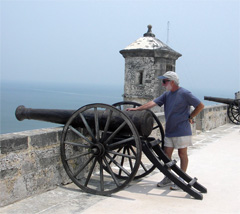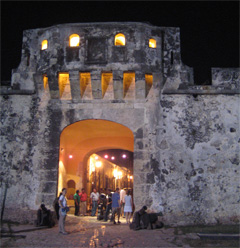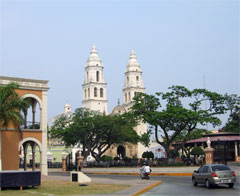Burrowed into the southeast part of the Yucatan Peninsula stands the walled fortress of Campeche—a city born from warfare and piracy.
 Before the arrival of the Spanish Conquistadors, Campeche was the principal town of the Mayas, who called it Ah Kin Pech (serpent tick), which the Spanish interpreted as “Campeche.”
Before the arrival of the Spanish Conquistadors, Campeche was the principal town of the Mayas, who called it Ah Kin Pech (serpent tick), which the Spanish interpreted as “Campeche.”
Led by Hernandez de Cordova, Spanish explorers set sail from Cuba in 1517 to search for new lands. Cordova is credited with the discovery of the Yucatan Peninsula.
Their first landing was at the Mayan village of Catoche where the natives greeted the conquistadors with an ambush and drove them back to sea. After fifteen days adrift without adequate supplies or water they ventured ashore again, this time at Campeche. Here, what seemed to begin as a friendly welcome turned into a simple choice—the high priest of the village set fire to a pile of reeds and told the sailors if they were not back to their boats before the blaze burned out, they would be used to rekindle the flames.
 Back at sea, the Spanish sailors worked their way down the coast until they arrived at Champotón. Locating food and water, the conquistadors also found themselves surrounded by Mayan warriors whose legions “seemed to multiply” until they outnumbered the Spanish 200 to one. The Mayans paid close attention to Captain Cordova, filling him with ten arrows that would eventually, five agonizing days later, claim his life. The Spaniards afterwards called the site costa de la mala pelea “the coast of the bad fight.”
Back at sea, the Spanish sailors worked their way down the coast until they arrived at Champotón. Locating food and water, the conquistadors also found themselves surrounded by Mayan warriors whose legions “seemed to multiply” until they outnumbered the Spanish 200 to one. The Mayans paid close attention to Captain Cordova, filling him with ten arrows that would eventually, five agonizing days later, claim his life. The Spaniards afterwards called the site costa de la mala pelea “the coast of the bad fight.”
In 1541, after the Mayans were finally subdued, the Spanish town of Campeche was founded. Once conquered, the harvest of the area’s abundant natural resources began. Before long, Campeche grew to be one of the richest cities in Mexico, second only to Veracruz in its wealth.
 One commodity in particular led to this boom, the precious logwood tree, a medium-sized evergreen with yellow flowers. Profiteers quickly learned that the tree was also the source of rich violet and black dyes used by the natives to color their textiles. In Europe, these hues were produced by indigo dyes, exotic and affordable only to royalty and the rich. The introduction of the logwood dye provided a less-expensive alternative.
One commodity in particular led to this boom, the precious logwood tree, a medium-sized evergreen with yellow flowers. Profiteers quickly learned that the tree was also the source of rich violet and black dyes used by the natives to color their textiles. In Europe, these hues were produced by indigo dyes, exotic and affordable only to royalty and the rich. The introduction of the logwood dye provided a less-expensive alternative.
The export of logwood thrived as ships filled with cut sections sailed back to Spain. It did not take long before the success of this business caught the attention of a particular group of people—pirates.
These pirates, the swashbuckling characters popular in movies and stories, including Henry Morgan and Francis Drake, were privateers holding government commissions backed by Henry VIII and Elizabeth I. The monarchy understood that fifty tons of logwood in a single trip would fetch more than a year’s worth of other cargo. So, the resources in Campeche became a target for attacks by pirates who beleaguered the town forcing officials to erect giant walls to protect against raids.
Wealth not commandeered by pirates was put toward construction which can still be seen in the splendid colonial architecture. Named a UNESCO World Heritage site in 1999, the colonial city of Campeche is well worth a visit.
